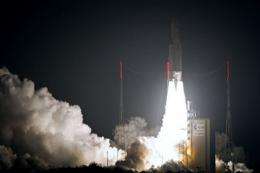European cargo vessel docks with space station

An unmanned European craft docked with the International Space Station (ISS) on Wednesday 2233 GMT, laden with tonnes of fuel, water, oxygen and other supplies, France's CNES space agency said.
The robot freighter hooked up with the station, which is currently staffed by six astronauts, the National Centre for Space Studies (CNES) said.
The Edoardo Amaldi, a 20-tonne Automated Transfer Vehicle (ATV) gently hooked up to the ISS after inching its way through the last 250 metres (yards).
It was completing its journey after its launch Friday morning by an Ariane 5 rocket from Kourou in French Guiana.
It is the third of five ATVs that the European Space Agency (ESA) is contracted to provide for the ISS.
European engineers say it is the most sophisticated unmanned ship in the history of orbital space, being able to navigate by starlight and then dock automatically, using laser guidance and video telemetry.
The size of a London double-decker bus, the Edoardo Amaldi was launched on March 23 by a heavyweight Ariane 5 rocket.
It carries a load of 6.6 tonnes, the biggest of Europe's replenishment missions so far.
Cargo includes four tonnes of onboard fuel, which will be used to boost the ISS to higher orbits, as well as oxygen, water, food, clothing, toiletries, medical supplies, spare parts and experiments.
One of the most important items is a fluid control pump that helps recycle urine into drinking water.
The ISS crew currently has only one of these devices, and if it breaks down, the astronauts will have to draw on their reserves of drinking water, ESA said.
The Edoardo Amaldi will be moored for nearly six months to the Russian module Zvezda.
It will provide extra room for the crew and occasional boosts to the station, using its onboard engines to rectify the ISS's orbital decay.
The station orbits at a height of around 400 kms (250 miles) but is tugged earthwards by gravity and lingering molecules of atmosphere.
Filled with rubbish from the station, the craft will then detach and burn up in a controlled destruction over the southern Pacific.
(c) 2012 AFP





















